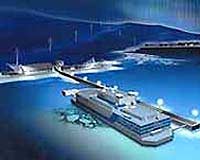Before the Chernobyl accident threw everything atomic into disrepute, Soviet economic planners dreamed of mobile nuclear power stations that would light up remote Arctic towns.
Public antipathy and economic woes shelved those dreams for two decades. But now, under direct orders from the Kremlin, ambitious Soviet-era expansion plans are being dusted off and rapidly implemented – including the first-ever floating atomic power station, set to begin operations in the frigid White Sea by 2010.
In a sweeping revival of Russia's nuclear industry, President Vladimir Putin has signed off on the construction of 26 major new nuclear stations, which will almost double the share of atomic power in Russia's electrical grid. In addition, the country's main atomic agency says it hopes to export as many as 60 nuclear power plants in the next two decades.
Critics say those export plans – particularly for floating stations, which use uranium enriched nearly to weapons-grade level – pose a proliferation risk, and warn that the largely Soviet-era technology could have dire ecological consequences. But advocates say the expansion wave is unstoppable, due to a partial shift in public attitude, the exigencies of global warming, and increasing economic pressures.
"Russia's economy is growing faster than anyone predicted; it's outrunning the capacities of our energy sector," says Vladimir Fortov, director of the official Institute of High Energy Physics in Moscow. "We're already starting to feel shortages of electricity, even in the Moscow region."
About 15 percent of Russia's electricity comes from nuclear power. Putin wants to increase that to 25 percent or more by 2030.

